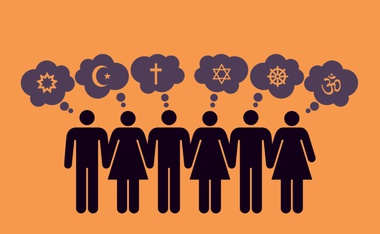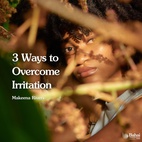The views expressed in our content reflect individual perspectives and do not represent the authoritative views of the Baha'i Faith.
Consider for a moment the possibility the three Faiths that arise from the children of Abraham – Judaism, Christianity, and Islam – are in fact one Faith.
I’m not talking about the oneness of their religious practices and customs; clearly these are different.
I’m talking about the possibility that each of these three Faiths come from the same God and act as agents of a single unfolding, synchronistic divine plan, as the Baha’i teachings claim. In his Book of Certitude, Baha’u’llah referred to the prophets and founders of these Faiths as “the revealers of one Truth:”
Purge thy sight, therefore, from all earthly limitations, that thou mayest behold them all as the bearers of one Name, the exponents of one Cause, the manifestations of one Self, and the revealers of one Truth, and that thou mayest apprehend the mystic “return” of the Words of God as unfolded by these utterances.
Yes, there are differences in the theologies and practices of these religions (especially between Christianity and the other two), but they arise from interpretative inventions, not from the original views of their founders.
To be sure, the Baha’i teachings say, other religions join with the Abrahamic religions in a common plan. But in these essays in our ongoing series, let’s focus on the scriptural connections between the three Abrahamic Faiths, and on the obstacles that prevent most Westerners from seeing Islam as part of a foreordained plan from the Creator.
RELATED: How the Prophets of All Faiths Are Connected
The Good that Comes from Religion
Viewed positively religions have performed the lion’s share of humanity’s social evolution, restraining forces of greed, injustice and aggression and providing a common ethic of behavior that allows people to come together and advance civilization. It is also true that many professed followers of religion have used the power of institutional religion to exert untoward authority over others and advance corrupt desires. While this is true of all religions, here we will examine Islam considering its promise and diversions.
To have any chance of seeing Islam’s promise, we must return to its beginning and examine it in perspective. After all, Baha’is believe in unity – and believe that all religions of the past, including Islam, are divine in origin and deserve reverence and respect.
Most Westerners growing up in Judeo/Christian cultures are understandably and regrettably ignorant of much of the positive history of Islam. Instead, what we tend to hear is a reminder of present differences and incompatibilities. Things did not start out this way; nor are they likely to end this way.
When I grew up as a Christian youth, long before I discovered the Baha’i Faith, the only thing I knew about Islam I learned through singing about the Children’s Crusade in the 13th century. This happened when kids were scooped up and told to go and make war on — or so we were taught in church — the “ungodly Moors” who had captured Jerusalem.
We sang that Muslims were dangerous, held wrong views, and needed to be subjugated – in a children’s song! In effect, we were told to wage jihad against them. Actually, Jerusalem had been in Muslim hands for about 600 years by the time of the Children’s Crusade, and for most of that time Muslims had fostered a tolerant, multicultural, multi-religious society in that city and throughout their lands. But I only learned that fact as an adult, not as a Christian child.
Sadly, not much has changed in the Western understanding of Islam, though now with information technology it’s easier to consider it fairly if the right sources are used. We will not, however, appreciate Islam through modern and/or prejudiced eyes. We must see it through the eyes of the times in which it arose and within the context of scripture – and also in an open-minded way. Then, if we are lucky, Islam will transform before our eyes, will reveal its greatness, beauty, and mission to us, as well as its tragedies and corruptions.
How Islam Appeared
Islam started like this: Six hundred years had passed since Christ had been crucified. As the Gospel of Matthew (24:7) had predicted, nation had risen against nation, kingdom against kingdom. Wars, in fact, had been continual. First there were the many Roman wars, then, in the time approaching the advent of Muhammad, the Sassanian Persians conquered all of Syria, Palestine and Egypt. They captured Jerusalem in 614. Alexandria fell in 619, and the Persians extended their empire all the way to the outskirts of Constantinople. It wasn’t until 629 CE when they retreated to their traditional border at the Khabur River, roughly at the modern Eastern border of Syria.
There had also been earthquakes, famines, and terrible plagues. A large earthquake hit Antioch in 115 killing approximately 250,000. One hit in Crete in 365 and Antioch was hit again in 526 killing another quarter-million people. Beirut, Tyre and Lebanon were hit in 551 with over 30, 000 killed. A massive volcano in 535 CE (Krakatoa) led to subsequent worldwide crop failures. Wars and environmental stress dislodged farmers, and sieges caused cities to starve.
RELATED: Reading the Great Spiritual Teachings – of Every Faith
The bubonic plague hit Syria and Egypt in 540 CE and Constantinople in 542 CE. Scholars estimate it killed a third of the population. Thus, there had been wars, earthquakes, famines, and false prophets by the time of Muhammad. In addition, the unity of the Christian church had been damaged beyond human repair with the division of the community into many groups with incompatible religious doctrines. Further, injustice still reigned in the world.
At that point, humanity greatly needed a promised Comforter – parakletos in Greek.
But we were also in need of a Praised One, pariklytos in Greek, an exemplary leader to guide us out of this mess. It has not gone unobserved that pariklytos could have been falsely transcribed as parakletos when it entered the New Testament narrative. Why is this of interest? Because in the language of Jesus, Aramaic, the word for “praised one” is mawhamana — the root word for the name Muhammad. Muslims point to Chapter 97 of the Gospel of Barnabus where it quite clearly identifies the name of the Promised One as Muhammad.
Here’s my point: Imagine yourself as a Christian in the seventh century, living near the Muslim expansion. If you had been attentive to what the scriptures say about the signs of the times and its needs, you would probably have become a Muslim. Many did, and to them Islam was a great blessing. Muhammad created a civilization that was the light of the world for hundreds of years, and he also clarified some important theological points.
Chief among the Christian beliefs that needed correction was the idea that Jesus was God. He was, as he said, the Son of man. But he was not just a man — rather, as the Qur’an made plain, he was a Chosen One, one of the great holy messengers periodically sent to guide people to God. Further, his ministry was one of particular power, beauty, and illumination.
Scripture says that the Son of Man was to come again in the clouds. Clouds obscure things. The fact that we still have trouble seeing Muhammad as part of God’s divine plan is continuing testimony to the precision of that prophecy.
















Comments
Sign in or create an account
Continue with Googleor